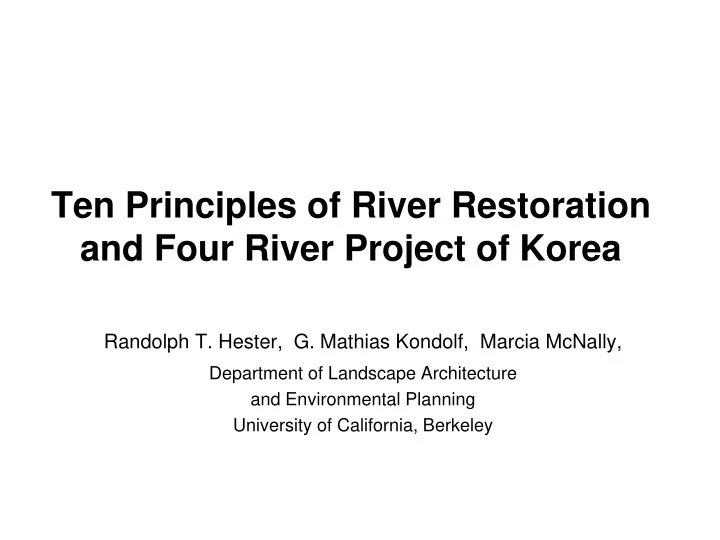

Ten Principles of River Restoration and Four River Project of Korea Randolph T. Hester, G. Mathias Kondolf, Marcia McNally, Department of Landscape Architecture and Environmental Planning University of California, Berkeley
Larger rivers and streams are conventionally put in straight concrete and earthen channels Flood control channels have high velocities across entire width; Fish are washed out, People die if caught in the channel in flood Unfriendly to animals and people
Pervasive impacts = loss of species diversity, ecosystem function through: Catchment land-use impacts on water quality - agriculture, urbanization, deforestation Dams, diversions - change flow regime, trap sediment Navigation - snagging, channelization/simplification Flood control - Levees disconnect floodplains - Reservoirs reduce peak flows Floodplain conversion - to agriculture, urban uses, loss of riparian habitat Bank stabilization - rocking banks to stop erosion/migration
The new approach: Restore function, Recreate complex natural channels, Restore meander bends
From 1990-2004 at least 37,000 restoration projects with over $17 billion in investment were documented in the U.S. (Bernhardt et al. 2005). The goals of most of these projects were to enhance or rehabilitate river ecosystems degraded by previous actions such as channelization, dredging, straightening, dam building, gravel mining, or diversion. These are the lessons learned to date. 1. Preserve what’s working 2. Restore process not form 3. Do no harm 4. Set goals in the context of constraints and opportunities 5. Prioritize projects at the system-wide scale 6. Learn from restoration 7. Empower rivers through legislation understood by the public 8. Make river decisions transparent 9. Make river restoration a part of everyday life 10. Build a constituency of stewardship system-wide
1. Preserve what’s working
2. Restore process not form
Restoring connectivity: longitudinal Dam Removal -restore fish migration -remove risky dams filled with sediment So far mostly small dams removed Key issue : What to do with the sediment? Impacts on downstream populations/structures
Matilija Dam, Ventura River, California Filled with sediment, poses safety hazard Blocks migration of steelhead trout Will be removed (eventually!) Potential downstream sediment effects the overriding issue
Friant Dam (1940s) blocked upstream migration and so reduced flows that the river dried up downstream once-mighty Spring-run salmon exterminated from river
Historical-geomorphic analysis showed that 1949 flood control project changed channel from multi-threaded, complex, shaded, frequent pool-riffle alternations to simplified, wider channel with high shear stress in floods. (Added gravels and planted trees would scour) Less complex habitat, less hyporheic interaction. To restore habitat, restore floodplain 1938 1996 connectivity!
3. Do no harm
Apalachicola River, Florida: How to Restore? - History of navigational dredging by US Army Corps, disposal of dredged sand, channel instability/enlargement, water level decline from channel change and reduced flows from catchment (Atlanta, center-pivot irrigation SW Georgia) - Side channels/sloughs dried out from lowered water levels, - Meander bends cut-off for navigation Restoration/mitigation projects seek to reconnect side channel habitats – not sustained, fill with sediment. Battle Bend: repeated excavations, largest in 2006, ph 2 to open upstream inlet to flush sediment
4. Set goals in the context of constraints and opportunities
5. Prioritize projects at the system-wide scale
Restoring Process Keeping the big picture in mind
what will The Downs Cascade of Geomorphic Processes happen re-configure channel and augment gravels Floodplain Watershed Inputs & grading & side- Channel & Network channels Connectivity Fluvial Geomorphic Processes restore riparian vegetation (active/ passive ) Physical Attributes flows altered & coarse sediment supply Habitat Structure, decreased Complexity & Connections channel & floodplain Biotic Response dredged & confined what has happened Hierarchy of processes influencing watershed biological baseline conditions.
Reducing Non-point Source Pollution: Managing Urban Stormwater Runoff Objectives: Slow, hold back runoff Infiltrate runoff into the ground Filter runoff through vegetation and soil Swales : Graded, engineered, shallow, vegetated open channels that convey water but slowly, filtering runoff in vegetation, and allowing some water to infiltrate
6. Learn from restoration
Temperature sensors deployed by Mark Tompkins
7. Empower rivers through legislation understood by the public
8. Make river decisions transparent
9. Make river restoration science a part of everyday life
‘Daylighting’ buried urban creeks one of the first: Strawberry Creek Park, Berkeley, California 1980s
10. Build a public constituency of stewardship system-wide
Recommend
More recommend